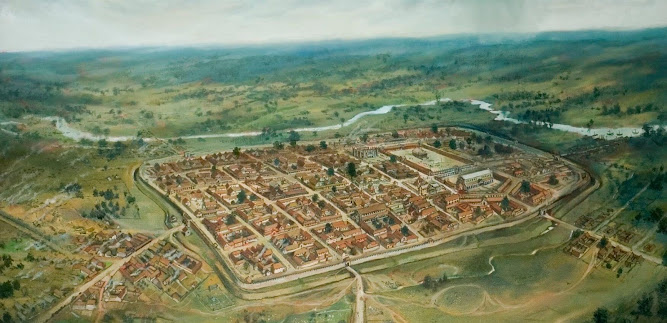The Balkerne Gate is still there by the way, half knocked down, and somewhat secured by recent council action. When the railway arrived around 1850, way down the hill, the publican situated at the gate took it upon himself to knock portions of it down thus enabling those arriving by train to see his Hostelry. It was an unwise step from a historical viewpoint, and I doubt it was very successful from his viewpoint as the walk uphill is indeed steep, but few would notice his pub from the station.
The wall had been built not long after Boudica and her Iceni friends arrived and burnt the place to the ground. Only the large cellar of what is now ‘Colchester Castle,’ remained, and that filled with burnt corpses. The people, now Romanised, were not regarded as loyal to the lady, therefore she treated them to the same regard she had already passed over to Verulaneum and Londinium. She was quite keen to share slaughter between all Romanised types.
Thus the wall that had not been erected in her day arose. An unfortunate mistake the Romans did not make again. No matter how trustworthy the Brits around them, the Romans built walls and defensive fortifications where they required them.
The soldiers would notice the road. It is possible they themselves had been involved in hardening the road themselves. Roman soldiers quickly learnt how to build fortifications, roads, and buildings to accompany them wherever they went. Partly this kept them busy, partly it kept them fit, always it enabled fast travel by the standards of the day for this vast military machine.
To this day the road remains almost exactly as it was then, heading west, it stretches out for 15 miles, up hill and down dale, nothing the soldiers would have found troublesome however, and after some fifteen miles (a days march) they would stop at a crossroads for the night, eat sleep and continue in the morning.
Sleep would be welcomed after the march as unless a few horse drawn carts could be found the soldier had to carry his own equipment, around 80 pounds in weight, similar to UK soldiers today.
He wore a tunic under his armour, a helmet on his head and his red cloak on his back. On his feet he wore military boots while carrying his shield and Pilum (his spear) and his sword dangled from his the belt around his waist. On the march much of this was thrown over his shoulder to make life easier, though how much easier the army personnel may dispute. On normal marches they would build a fort each night, a hard but important job in dangerous places. I suspect this was not required in what is now Essex as surely such accommodation as required was permanently built. However, I know not if this is the case.
Leaving the walled city was always dangerous for Romans, while most Brits were happy in these parts the experience of Boudica had left the Romans and the Romanised locals wary. At no time did Rome believe this land was secure enough to withdraw troops, they remained for several hundred years because of the troublesome natives.
Leaving the city the march takes them through Lexden, now a nice suburb for those who can afford it and then the outer reaches of defensive ditches created in the first century BC. Long ditches were dug in several places, with more added over the next 200 years. The Trinovanti had long suffered problems from the Catuvellaunii who ought to have remained in Hertfordshire where they belonged. This they did not and eventually took over Catolodunon (as called before the Romans changed the spelling) including the area of Lexden where a number of tombs can be seen, or mounds may be a better description, including one supposed to contain the remains of Cunobelinus, known as Cymbeline to some, the King of the Catuvellaunii.





































